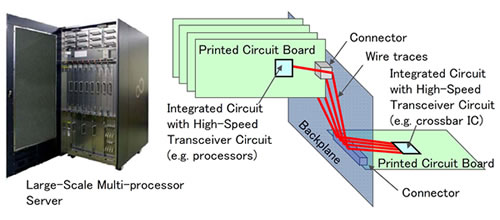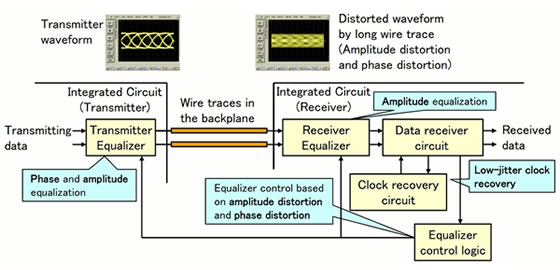Archived content
NOTE: this is an archived page and the content is likely to be out of date.
Fujitsu Develops High-Speed Transceiver Circuit Enabling Extension of In-Server Data Transmission Distance by 1.7 Times
Achieves both high speed and long distance; realizes high-performance large-scale servers
Fujitsu Laboratories Ltd.,Fujitsu Laboratories of America Inc.
Kawasaki, Japan and Sunnyvale, U.S., February 24, 2011
Fujitsu Laboratories Ltd. and Fujitsu Laboratories of America, Inc. today announced the development of a high-speed multi-channel transceiver circuit that operates at 10 Gbps and extends in-server data-transmission distances by a factor of 1.7 over existing technology. This technology would be put to use in backplanes(1) that serve as communication channels in multi-processor servers, which combine multiple CPUs for higher performance. The new technology can compensate for distortions in data signals that would become evident when channels are lengthened, and allows these channels to be extended from the current distance of 70 cm to 120 cm(2). Fujitsu's new technology will enable the realization of large-scale high-performance server systems that can connect a great number of more processors than previously possible.
Details of the technology were presented at the IEEE International Solid-State Circuit Conference 2011 (ISSCC 2011), being held in San Francisco from February 20 - 24.
Background
Datacenters that support modern cloud-computing systems rely on high-performance, high-density server systems, and typically use either blade servers or large-scale multi-processor servers. Both types of servers use a circuit board called a backplane, on which other circuit boards containing processors and data-communication chips are densely installed. The backplane is designed to enable communications between these other circuit boards (Figure 1).
In order to achieve systems with higher performance in the future, these backplanes will need to be able to pass data signals at higher speeds, and to connect more processors into larger systems.
 Figure 1: A high-speed transmission channel in a server using a backplane
Figure 1: A high-speed transmission channel in a server using a backplane
Larger View (66 KB)
Technological Challenges
With backplanes operating at transfer speeds of 10 Gbps, transmission losses result in signal distortions, making it impossible to transmit the data correctly. Furthermore, if the signal distortions become too large, it becomes difficult to accurately recover the clock signal components to detect either "0" or "1" data values.
These signal distortions increase with higher transmission speeds and longer transmission channels, so that in existing multichannel transceivers, the distance limit for 10 Gbps communications has been 70 cm(3). This makes it difficult to speed up communications in large-scale servers - which measure 85 cm wide - and pose a challenge to extending the transmission distance for high-speed transceivers.
Newly-developed Technology
Fujitsu Laboratories developed a new signal-processing algorithm that compensates for the amplitude distortion(4) and phase distortion(5) that emerges over long backplane channels, so that signal distortions resulting from a maximum of 41 dB of loss at 10 Gbps can still be fully corrected. The result is that backplane channels can be lengthened by a factor of 1.7, to 120 cm.
Key characteristics of the new technology are as follows.
1. Phase-distortion compensation
Fujitsu Laboratories developed a technology that watches for and detects phase distortions that emerge over long backplane signal channels, and that can accurately correct data through applied control of signal-compensation circuits (equalizer circuits) on both the sending and receiving side.
2. Precise clock-signal generation
To minimize the negative impact of noise components remaining after compensating for distortions arising from long signal channels, Fujitsu Laboratories developed a circuit that generates a more accurate clock, making it possible to select parts of the transmitted data that are relatively unaffected by the noise. Extracting an accurate clock signal makes it possible to distinguish "1"s and "0"s in the data with accuracy.
 Figure 2: Block diagram of Fujitsu's new technology for a high-speed transceiver circuit enabling extension of in-server data transmission distance by 1.7 times
Figure 2: Block diagram of Fujitsu's new technology for a high-speed transceiver circuit enabling extension of in-server data transmission distance by 1.7 times
Larger View (75 KB)
Results
Employing this high-speed transceiver circuitry for integrated circuits made it possible to maintain high-speed communications over longer transmission channels, paving the way for large-scale, high-performance server systems featuring more processors. Also, because this circuitry was able to reduce signal distortions to below current levels, circuit boards that were thus far made with expensive materials in order to minimize losses, could be made more inexpensively of materials that result in relatively high losses, while still achieving 10 Gbps throughput.
Future Developments
Fujitsu Laboratories plans to extend this technology to the latest process technologies and apply it to high-performance server systems.
About Fujitsu Laboratories
Founded in 1968 as a wholly owned subsidiary of Fujitsu Limited, Fujitsu Laboratories Limited is one of the premier research centers in the world. With a global network of laboratories in Japan, China, the United States and Europe, the organization conducts a wide range of basic and applied research in the areas of Next-generation Services, Computer Servers, Networks, Electronic Devices and Advanced Materials. For more information, please see: http://jp.fujitsu.com/labs/en.
About Fujitsu Laboratories of America, Inc.
Fujitsu Laboratories of America, Inc. is a wholly owned subsidiary of Fujitsu Laboratories Ltd. (Japan), focusing on research on advanced VLSI CAD, Internet, and interconnect technologies. Conducting research in an open environment, it contributes to the global research community and the working IT industry. It is headquartered in Sunnyvale, CA.
For more information, please see: www.fla.fujitsu.com
Press Contacts
Public and Investor Relations Division
Inquiries
Company:Fujitsu Limited
Technical Contacts
IT Systems Lab.
Server Technologies Lab.
 Phone: +81(44)754-2177
Phone: +81(44)754-2177
 E-mail: hsio-info@ml.labs.fujitsu.com
E-mail: hsio-info@ml.labs.fujitsu.com
Company:Fujitsu Laboratories Ltd.
Company and product names mentioned herein are trademarks or registered trademarks of their respective owners. Information in this press release is accurate at time of publication and is subject to change without advance notice.
Date: 24 February, 2011
City: Kawasaki, Japan and Sunnyvale, U.S.
Company:
Fujitsu Laboratories Ltd.,
Fujitsu Laboratories of America, Inc.,
,
,
,
,
,
,
,
,
![]() Phone: +81(44)754-2177
Phone: +81(44)754-2177![]() E-mail: hsio-info@ml.labs.fujitsu.com
E-mail: hsio-info@ml.labs.fujitsu.com
